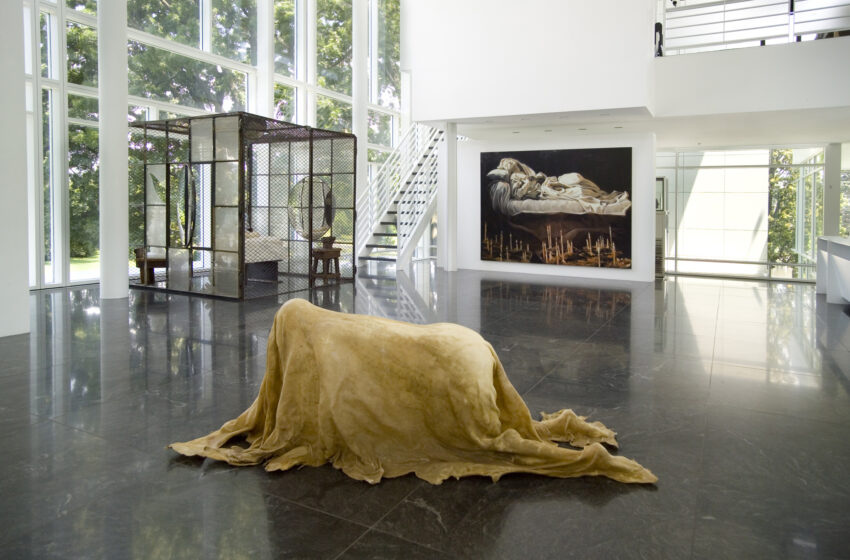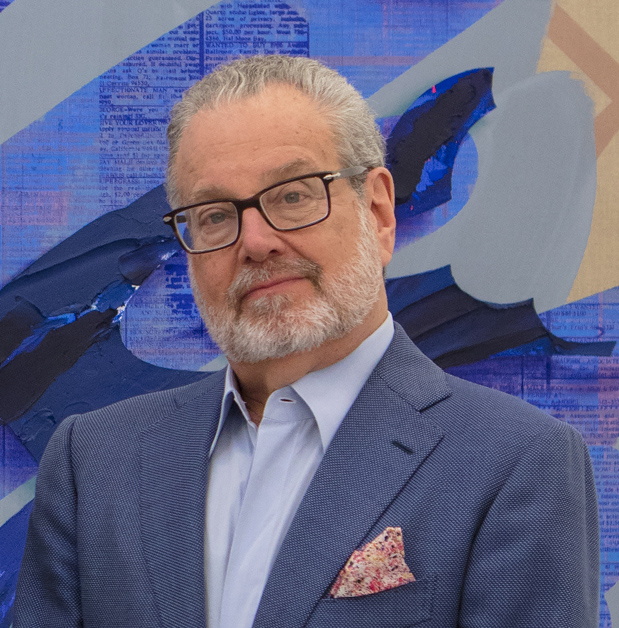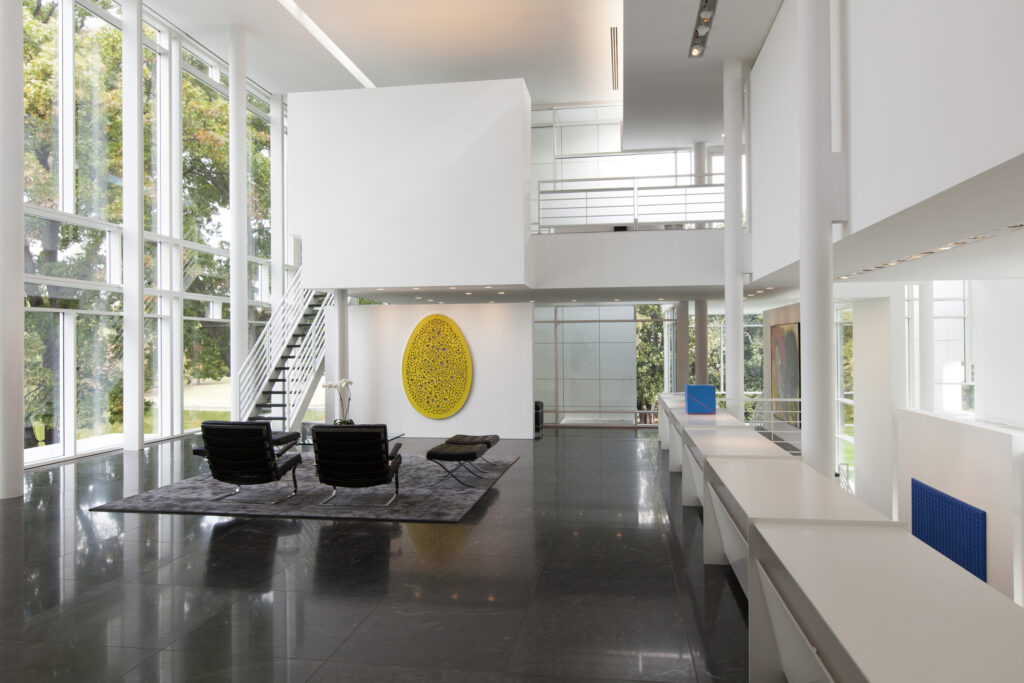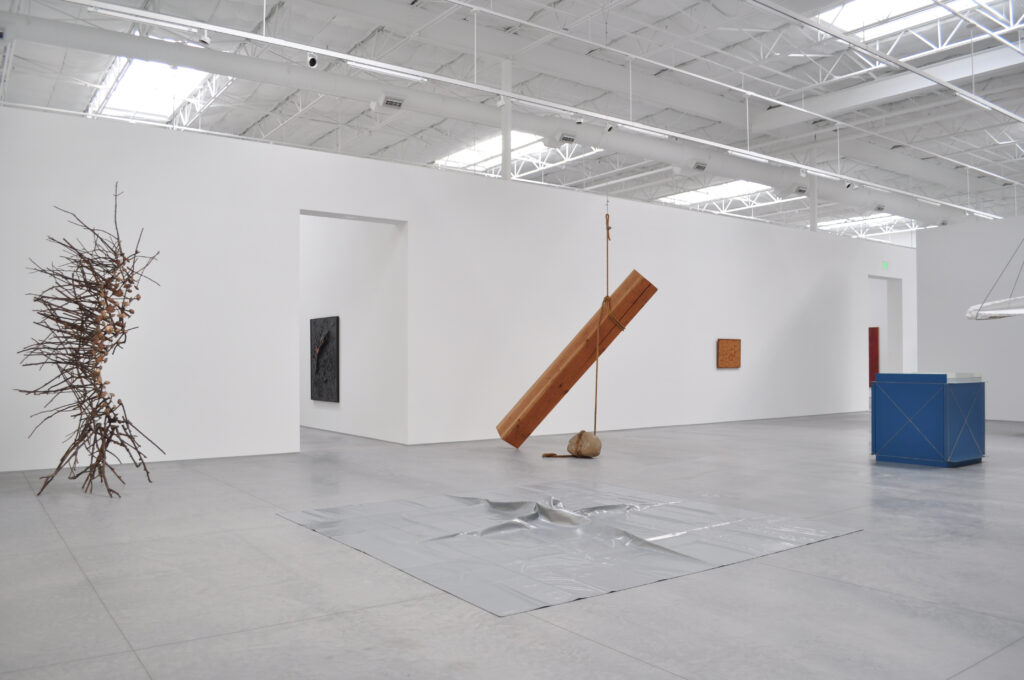The Collector: A Conversation with Howard Rachofsky

Howard and Cindy Rachofsky live in no ordinary house. It is more “an investigation into all of the possibilities of house,” in the words of its designer, the modernist architect Richard Meier. The Rachofsky House — a three-story, 10,000-square-foot white cube in the Preston Hollow neighborhood of Dallas — is home to one of the most celebrated collections of contemporary art in Texas. But it’s very much a work of contemporary art in its own right, wrestling with tensions between communal and intimate space and natural and constructed environments.
Early in his career, Howard Rachofsky could hardly have imagined his name on such a structure, nor being the mind, along with his wife, behind the 1,300 artworks rotated throughout the house and its surrounding lawns. The son of a Dallas pawnshop owner, Rachofsky went to the Wharton School before returning to Texas for a career as a hedge fund manager. He started out with no real knowledge of art; in his time as a college student in Pennsylvania, not once did he visit the celebrated Philadelphia Museum of Art, less than two miles away. And his entrée into art collecting took place years later, when he bought a few Picasso and Matisse prints for his apartment walls.
Nevertheless, a slow, inexorable fascination with fine art took hold of Rachofsky over the 1980s and 1990s — to the point that art collecting is now a full-time pursuit. In this conversation, Rachofsky explains his evolution into a top Texas art collector, the difference between collecting and accumulating, and why CEOs should care about visual arts.

Texas CEO: What was your first exposure to fine art? Were you exposed to a lot of art as a child?
Rachofsky: Not at all. My first exposure was relatively late in life. I just didn’t have a connection or an interest. I didn’t take art history in college and didn’t have any real experience with visual arts until I graduated from law school in the early 1970s. Sadly, in retrospect, I would have become a much wiser collector had I learned more earlier.
Shortly after graduating law school in Austin and moving back to Dallas, I was introduced to an art dealer named Ralph Kahn who ran the Contemporary Gallery in the Quadrangle. That meeting was more serendipity than anything else, and I fell under his spell a bit.
For whatever reason, it was at that point that fine art touched a nerve with me. I began going to Ralph’s gallery once every six weeks or so to buy a little something, have conversations with him. In those days, I had few financial resources and very limited knowledge, so the initial collecting was mostly contemporary and modern master prints. I wouldn’t even call myself a collector back in the seventies. I was more an accumulator of a few things to put on the walls of an apartment. I had no sense it would evolve into what it ultimately became.
Texas CEO: How did you transition from decorating and accumulating into collecting contemporary art?
Rachofsky: Through a series of random events I was introduced to a dealer named Ann Freedman in New York. Whenever I was there, I started dropping into the Knoedler Gallery, where she was director. She was really my second important point of contact in the art world, and by the early 1980s, I was becoming more and more interested. I spent most of my time working, but my diversion became going to the gallery to talk about art. I bought some really nice artworks from Ann, though interestingly enough, almost none remain in the collection today. Over four decades, taste changes.
By the late 1980s, I had more resources and was collecting more. And by then I was also under the influence of two new people — a collector from Dallas and her former college roommate, who was a substantial collector in New York. They were both gadflies of a sort who spent their time going to all sorts of art galleries, 24/7. For better or worse, they took me under their wing and dragged me around to galleries. I’d say that was my first real immersion in the art world.
Texas CEO: How did the Rachofsky House come about?
Rachofsky: I was introduced to the architect Richard Meier, a major modernist architect from New York, in the 1980s, and I commissioned him to build a house. It would be the first Richard Meier house west of the Mississippi. That house was completed in 1996. By then, I’d acquired a good deal of art, and now had a place to properly display it.
In the process of working with Richard, I was introduced to a young man named Allan Schwartzman, who came recommended as an advisor, someone to help me build a true art collection. I date the beginning of my meaningful art collecting to that introduction. At the time, Allan was primarily a writer and art historian, and I became his first formal client in 1997. He and I continue to have an active working relationship, which is frighteningly almost 25 years old at this point. Allan has really been the intellectual and spiritual guide of The Rachofsky Collection. He taught me a lot. I’ve gotten my degree in art history through Allan.

Texas CEO: Is there any relationship between your former career as a hedge fund manager and your interest in art? Those seem like two very different pursuits.
Rachofsky: After I graduated from law school in 1970, I came back to Dallas and quickly found that I was not a good fit for the practice of law. I had a background in securities trading, and it became pretty clear I needed to move in that direction — I was sitting in a law office spending 50 percent of my time trading stocks. For decades after that, I spent 99 percent of my time focusing on my job as a hedge fund manager and 1 percent thinking about art.
But by 2003 I’d been in the securities business for three decades, and I realized it was time to move on from the stress and strain of that business. I was in my mid-fifties then. Because I was already immersed in collecting, I decided to do it full-time. I wouldn’t say it’s a profession, but it’s certainly beyond an avocation. Maybe it’s more accurately called an obsession or an addiction. Nonetheless, to this day most of my time is spent on developing the collection and exploring the arena of art.
Texas CEO: What led you to focus on contemporary art specifically?
Rachofsky: I’m drawn to the relevance and intellectual side of contemporary art. It’s not just beautiful pictures. Some of it is abstract; some of it contains narrative and deals with ideas. Contemporary art challenges your notions of what is interesting or valuable in art, and you begin to develop a vocabulary around how to describe that. I found that really energizing and fun from the beginning. Then, working with Allan catalyzed it into something more substantial.
One of the interesting phenomena in the world of contemporary art collecting is that it can become more like trophy hunting than what I call true collecting — especially when you have a type-A person and unlimited resources. True collecting isn’t just picking up a single painting by Gerhard Richter or Andy Warhol or Mark Rothko or another high-profile name. True collectors find as much interest in works of modest scale and expense when those works fit a larger narrative or style or theme. You can put trophies on the wall, but that doesn’t necessarily make you a collector.
People are, of course, still making those high-dollar purchases. There are two ways to measure art: by aesthetic value and by dollars and cents. When a collector spends $50 million or $100 million on a work of art, that’s news. It’s not necessarily the wisest decision, but if you have unlimited resources, which a lot of the bigger collectors do, those purchases are interesting opportunities. Of course, that’s just the very top in terms of wealth, the top one-tenth of the top one-tenth of the 1 percent — a few hundred people around the world, vying for the top spot.
But the art world is a much bigger place than that. Museums have become better at putting on programming that encourages modest collectors to get started. That permeates through society. You also see social movements influencing the art world, much as they influence politics and popular culture. In the past five or so years, we’ve seen the feminist and Black Lives Matter movements surface in the art world in a very powerful way. Visual culture is deeply connected to what’s going on in our society.
Texas CEO: How have you seen the art scene in Texas evolve over the years?
Rachofsky: When I started out, I didn’t know a lot of the players. But as I became more involved I developed a respect for the formidable people who built meaningful collections in Texas. There are three or four who are the lions of that. There’s John and Dominique de Menil of the Menil Collection in Houston, which was very avant-garde — and still feels that way. There’s Anne Marion, a great collector from Fort Worth, who passed away recently. She was really the spirit behind the Modern Art Museum of Fort Worth. And then there’s Ray and Patsy Nasher, who were great collectors of sculpture in Dallas. I had the pleasure of knowing Ray for the last 15 or 20 years of his life as I became more engaged.
These are the sorts of people who influenced me at the time. The Texas scene was relatively isolated back then, and still is, relative to places like LA and New York and London and Paris. It’s also still relatively modest in terms of scale, but there are more museums and more collections and more people interested in them. When I started getting engaged in art, you could have measured the contemporary art world by a thousand people — not very many in a planet of billions. Over time, millions more have become engaged, and I think Texas mirrors that.
I don’t think the Texas art scene is unique in the sense that we’re doing things others aren’t, but Texas is now becoming more part of the global art scene, even if, as I mentioned, we’re still somewhat isolated.
Texas CEO: What advice do you have for art collectors who are just beginning their journey?
Rachofsky: They can certainly get started a lot quicker and smarter than I did. It’s hard in the world at the current moment, but you need to go look at this stuff in person and see what inspires you — be it color, be it form, be it figurative art, be it abstract art. I’m a firm believer that you need to be in the physical presence of the work to get the full benefit. Museums, of course, are great resources for getting that experience. I encourage people to make museums part of any travel experience. Private collectors tend to still be very private and don’t want you to know what they have, but museums are a great repository of work available to the public. As you see different exhibitions, you develop your own preferences and judgments. That’s the first step.
If you find you do want to engage in collecting, you can begin with works of modest scale and expense, subject to your budget. If you decide to really immerse yourself, it’s wise to get professional advisory help just like you would from an attorney or an accountant. An art advisor can narrow your focus and help you get your arms around what inspires and interests you. You don’t have to wander in the darkness for 20 years like I did.

Texas CEO: Luckily for us, Texas has some very good museums. Do you have a favorite?
Rachofsky: I know you’re supposed to say, as my aunt used to say about her nephews and nieces, “My favorite is the one I’m with at the moment.” But I have to say the Dallas Museum of Art. I’m a past trustee there, and I’m close to the people there. I’m also a big fan of the Nasher; it’s a marvelous boutique. The Menil Collection in Houston is one of my favorite institutions, as is Dia Art Foundation in New York; I serve on the board there. Dia’s museum in Beacon, New York, is the ultimate in museum experiences. The aesthetic and the setting are so marvelous.
The Fort Worth museums are great too, of course. The Kimbell is a jewel box of great historical work. The Modern [Art Museum of Fort Worth] and the Amon Carter Museum [of American Art] are wonderful places as well. We have plenty of museums around the state where you can immerse yourself in the visual arts. Wherever you happen to be, go in and take a look — once they reopen, that is.
Texas CEO: You’re a client of the art services division at Bank of America. What has that experience been like?
Rachofsky: I’m grateful for the experience. They do a crackerjack job. The financing services specifically have allowed me the flexibility to buy and sell works and build out a collection that has its own personality. At the end of the day, that’s what most collectors want. They want their collection not only to reflect what’s happening at a particular point in time, but also their own personalities and instincts and desires and expectations. The art services portion of banking has matured into a very refined way to get counsel and financing for engagement in the art world.
Texas CEO: Anything else you’d like to say to Texas CEOs?
Rachofsky: I’d just like to point out that visual culture is important, even from a business and corporate perspective. I think that’s good for CEOs to keep in mind. Visual culture may not seem like it’s as important as supporting other causes — and I certainly don’t want to belittle those causes — but supporting culture is part of being a good citizen of the community. That’s encompassed in the CEO’s job, along with making money for shareholders and providing employment to your workforce. There are many ways to support local cultural institutions, and when you do so, you’re supporting the very evolution of civilization.






